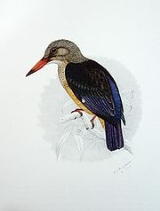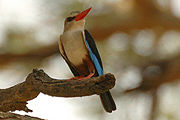
Grey-headed Kingfisher
Encyclopedia
The Grey-headed Kingfisher (Halcyon leucocephala) has a wide distribution from the Cape Verde Islands off the north-west coast of Africa to Mauritania
, Senegal
and Gambia, east to Ethiopia
, Somalia
and southern Arabia and south to South Africa
.
A dry-country kingfisher of scrub and woodland, solitary or in pairs, often found near water, but unlike most kingfishers is not aquatic. Perches on branch, unmoving for long periods while watching the ground for signs of insects or small lizards, bobbing head before diving on prey. In appearance very like the Woodland Kingfisher
but with a red rather than red and black bill and similar to the Brown-hooded Kingfisher
, but the Brown-hooded lacks the chestnut belly. Nests in holes in steep riverbanks and is aggressively protective of its nest by repeated dive-bombing of foraging Monitor lizard
s. It is parasitised by the Greater Honeyguide
. This species migrates at night and is often killed by flying into obstacles such as buildings, towers and powerlines.

Mauritania
Mauritania is a country in the Maghreb and West Africa. It is bordered by the Atlantic Ocean in the west, by Western Sahara in the north, by Algeria in the northeast, by Mali in the east and southeast, and by Senegal in the southwest...
, Senegal
Senegal
Senegal , officially the Republic of Senegal , is a country in western Africa. It owes its name to the Sénégal River that borders it to the east and north...
and Gambia, east to Ethiopia
Ethiopia
Ethiopia , officially known as the Federal Democratic Republic of Ethiopia, is a country located in the Horn of Africa. It is the second-most populous nation in Africa, with over 82 million inhabitants, and the tenth-largest by area, occupying 1,100,000 km2...
, Somalia
Somalia
Somalia , officially the Somali Republic and formerly known as the Somali Democratic Republic under Socialist rule, is a country located in the Horn of Africa. Since the outbreak of the Somali Civil War in 1991 there has been no central government control over most of the country's territory...
and southern Arabia and south to South Africa
South Africa
The Republic of South Africa is a country in southern Africa. Located at the southern tip of Africa, it is divided into nine provinces, with of coastline on the Atlantic and Indian oceans...
.
A dry-country kingfisher of scrub and woodland, solitary or in pairs, often found near water, but unlike most kingfishers is not aquatic. Perches on branch, unmoving for long periods while watching the ground for signs of insects or small lizards, bobbing head before diving on prey. In appearance very like the Woodland Kingfisher
Woodland Kingfisher
The Woodland Kingfisher is a tree kingfisher.-Description:This is a medium-sized kingfisher, 20–23 cm in length. The adult has a bright blue back, wing panel and tail. Its head, neck and underparts are white, and its shoulders are black. The flight of the Woodland Kingfisher is rapid and direct...
but with a red rather than red and black bill and similar to the Brown-hooded Kingfisher
Brown-hooded Kingfisher
The Brown-hooded Kingfisher is a species of bird in the Halcyonidae family.It is found in Angola, Botswana, Republic of the Congo, Democratic Republic of the Congo, Gabon, Kenya, Malawi, Mozambique, Namibia, Somalia, South Africa, Swaziland, Tanzania, Zambia, and Zimbabwe.-References:* BirdLife...
, but the Brown-hooded lacks the chestnut belly. Nests in holes in steep riverbanks and is aggressively protective of its nest by repeated dive-bombing of foraging Monitor lizard
Monitor lizard
Monitor lizards are usually large reptiles, although some can be as small as in length. They have long necks, powerful tails and claws, and well-developed limbs. Most species are terrestrial, but arboreal and semiaquatic monitors are also known...
s. It is parasitised by the Greater Honeyguide
Greater Honeyguide
The Greater Honeyguide is a bird in the family Indicatoridae, paleotropical near passerine birds related to the woodpeckers. Its English and scientific names refer to its habit of guiding people to bee colonies....
. This species migrates at night and is often killed by flying into obstacles such as buildings, towers and powerlines.


